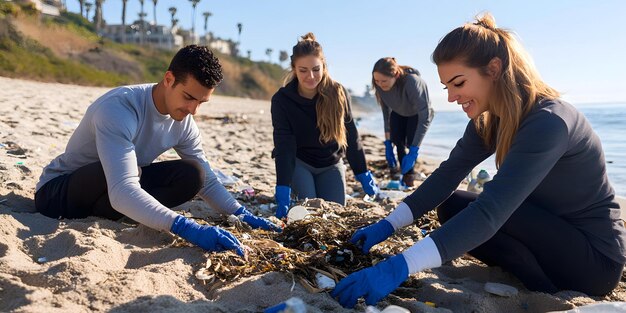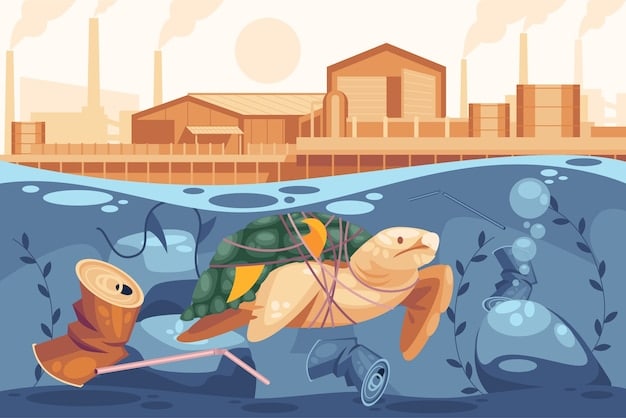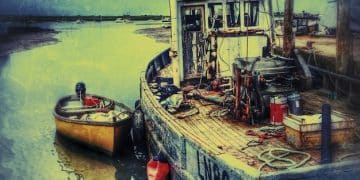Effective Strategies to Reduce Marine Debris in US Coastal Areas

Mitigating marine debris in US coastal areas necessitates a multifaceted approach, integrating robust prevention at the source, comprehensive cleanup efforts, and sustained public education to foster responsible behavior and support policy implementation.
The beauty of the US coastline, from the rugged shores of the Pacific Northwest to the sandy beaches of the Atlantic, is undeniable. Yet, this natural splendor faces a relentless adversary: marine debris. Understanding what are the most effective strategies for reducing marine debris in US coastal areas is paramount to preserving these vital ecosystems and the countless species that call them home.
understanding the challenge: sources and impacts of marine debris
Marine debris, broadly defined as any persistent, manufactured or processed solid material discarded, disposed of, or abandoned in the marine and coastal environment, presents a complex and pervasive challenge. Its origins are diverse, stemming from both land-based and ocean-based activities, making its mitigation a multi-faceted endeavor.
Land-based sources typically account for the vast majority of marine debris, estimated to be up to 80% of what eventually pollutes our oceans. This includes litter from urban and rural runoff, inadequately managed waste systems, illegal dumping, and even windblown debris from landfills. Think of plastic bags escaping bins, cigarette butts flicked onto sidewalks, or packaging washed into storm drains – all of which can ultimately find their way to a river and then the sea.
the pervasive nature of plastic pollution
Within this broad category, plastic stands out as the most ubiquitous and problematic component. Its durability, low cost, and widespread use contribute to its prevalence in marine environments. Unlike organic materials, plastics do not biodegrade in the ocean; instead, they break down into smaller pieces known as microplastics and nanoplastics, which are even more difficult to detect and remove. These fragments accumulate in the water column, sediments, and even the food chain.
- Single-use plastics: Items like plastic bottles, bags, straws, and food wrappers are major contributors due to their short use-life and common disposal.
- Fishing gear: Abandoned, lost, or otherwise discarded fishing gear (ALDFG), often referred to as “ghost gear,” is a significant source of marine debris, trapping and entangling marine life.
- Industrial pellets: Small plastic pellets, or “nurdles,” used in plastic manufacturing, are frequently spilled during transport and end up in the environment.
Ocean-based sources, while less dominant in volume, are equally impactful. These include debris from commercial fishing, shipping activities, offshore oil and gas platforms, and recreational boating. Accidents, improper waste disposal at sea, and abandoned vessels all contribute to this category.
The impacts of marine debris are far-reaching, affecting ecosystems, economies, and even human health. Marine animals can become entangled in larger pieces of debris, leading to injury, starvation, or drowning. Ingestion of plastics, from large fragments to microscopic particles, can block digestive tracts, cause internal injuries, and introduce harmful chemicals into the organisms, with potential ripple effects up the food chain. This can lead to reduced reproductive success, compromised immune systems, and ultimately, population declines for many species.
Economically, marine debris imposes substantial costs. It damages fishing gear, interferes with navigation, and reduces the aesthetic appeal of beaches, impacting tourism and recreational industries. Coastal communities bear the financial burden of cleanup operations. Furthermore, the presence of microplastics in seafood raises concerns about potential human health impacts, although research in this area is still evolving. Understanding these intricate connections between sources and impacts is the foundational step in developing effective mitigation strategies.
prevention at the source: curbing the flow of debris
The most effective strategy for reducing marine debris is preventing its entry into the marine environment in the first place. This requires a systemic shift in how we produce, consume, and dispose of materials, particularly plastics. Focusing on upstream solutions addresses the root causes of pollution rather than merely dealing with its consequences.
One critical component is policy and regulation. Governments at federal, state, and local levels can enact legislation that reduces plastic production and encourages sustainable alternatives. This includes bans or restrictions on single-use plastic items that are frequently found as marine debris, such as plastic bags, straws, and polystyrene foam products. Extended Producer Responsibility (EPR) schemes can also hold manufacturers accountable for the entire lifecycle of their products, incentivizing them to design for durability, reusability, and recyclability.
innovations in sustainable materials and packaging
Beyond restrictions, promoting innovation in sustainable materials is key. Research and development into biodegradable or compostable alternatives to conventional plastics, particularly for packaging, can significantly reduce environmental persistence. Companies are increasingly exploring options like plant-based plastics (e.g., PLA from corn starch), mycelium-based packaging, and seaweed-derived materials. These alternatives, when properly designed and managed, can offer functional replacements with reduced ecological footprints.
- Bioplastics: While not a panacea, certain bioplastics offer a reduced environmental footprint, especially when coupled with robust composting infrastructure.
- Reusable systems: Shifting from disposable to reusable models, such as refillable containers for beverages and detergents or reusable shopping bags, dramatically cuts down on waste.
- Redesigned packaging: Minimalist packaging, use of recycled content, and elimination of unnecessary plastic components can reduce material consumption.
Improving waste management infrastructure is another cornerstone of prevention. In many US coastal areas, while municipal waste collection is widespread, gaps remain in recycling accessibility, particularly for specific types of plastics. Investing in advanced sorting technologies, expanding curbside recycling programs, and establishing convenient drop-off points for hard-to-recycle items can divert significant amounts of waste from landfills and, consequently, from the ocean. This also involves addressing illegal dumping, through increased enforcement and public awareness campaigns about proper disposal methods.
Consumer behavior plays a crucial role. Empowering individuals with information about the impact of their choices and providing accessible alternatives can foster a culture of reduced consumption, reuse, and responsible disposal. This includes promoting the use of reusable water bottles and coffee cups, encouraging the rejection of single-use plastics at retailers, and supporting businesses committed to sustainable practices. Ultimately, prevention at the source requires a collaborative effort from policymakers, industry, innovators, and individual citizens to collectively reduce the demand for and proliferation of harmful materials.
cleanup initiatives: mitigating existing pollution
While prevention is paramount, an enormous amount of marine debris already exists, accumulating on beaches, floating in ocean gyres, and settling on the seafloor. Therefore, robust cleanup initiatives are essential to mitigate current pollution and minimize its ongoing impacts on marine ecosystems and coastal communities.
Coastal and beach cleanups are perhaps the most visible and widely practiced form of marine debris removal. These efforts, often led by volunteer organizations, community groups, and non-profits, directly remove debris from shorelines. Regular beach cleanups not only remove visible trash but also raise public awareness, encouraging participants to become more mindful of their own waste generation. Major organizations like the Ocean Conservancy’s International Coastal Cleanup have mobilized millions of volunteers globally, documenting the types and quantities of debris collected, which provides valuable data for policy and prevention efforts.

innovations in ocean and seafloor cleanup technologies
Beyond shorelines, efforts are expanding to tackle debris in the open ocean and on the seafloor. Technological advancements are enabling more sophisticated and large-scale cleanup operations. For instance, projects like The Ocean Cleanup utilize passively drifting systems designed to concentrate plastic debris in the Great Pacific Garbage Patch, allowing for more efficient retrieval. Other innovators are developing autonomous underwater vehicles (AUVs) and remotely operated vehicles (ROVs) equipped with cameras and robotic arms to locate and collect debris from the seabed, particularly in sensitive areas like coral reefs or deep-sea canyons.
- Passive collection systems: Designed to capture floating plastic using natural ocean currents, reducing the need for active propulsion.
- Subsea robotics: ROVs and AUVs can survey and collect debris from the seafloor, targeting ghost fishing gear and other submerged plastics.
- Spatially targeted cleanups: Using data from surveys and models to focus efforts on areas with high concentrations of debris, such as near river mouths or in ocean gyres.
Addressing abandoned, lost, or otherwise discarded fishing gear (ALDFG) is a particularly critical cleanup challenge. Ghost gear can continue to “fish” for decades, entangling marine life, damaging habitats, and becoming a navigational hazard. Specialized initiatives, often involving commercial divers and fishing communities, are dedicated to locating and removing ghost gear from specific hot spots. Programs that offer incentives for fishermen to retrieve their lost gear or return unwanted gear for proper disposal are also gaining traction, integrating cleanup with responsible practices within the fishing industry.
While cleanup efforts are vital for addressing existing pollution and mitigating immediate harm, they are not a standalone solution. They must be viewed as a necessary complement to prevention strategies, ensuring that the continuous influx of new debris does not overwhelm the capacity for removal. Effective cleanup also involves proper disposal of collected debris, preferably through recycling or responsible waste-to-energy processes, rather than simply transferring the problem to landfills.
policy, regulation, and enforcement: driving systemic change
Effective reduction of marine debris fundamentally relies on a robust framework of policies, regulations, and their consistent enforcement. These top-down measures provide the necessary structure to guide industries, municipalities, and individuals towards more sustainable practices, creating a level playing field and accelerating systemic change.
At the federal level, several acts and strategic plans contribute to marine debris reduction. The Marine Debris Act, first passed in 2006 and reauthorized multiple times, established the NOAA Marine Debris Program, enabling research, prevention, removal, and outreach initiatives. This act provides the legislative backbone for many efforts across the US, fostering collaboration among federal agencies, states, and non-governmental organizations. Other environmental regulations, such as those governing stormwater runoff and waste disposal, indirectly contribute by preventing land-based litter from reaching coastal waters.
state and local governance in action
State and local governments play an equally critical, often more direct, role in implementation. Many coastal states have enacted their own specific legislation targeting marine debris, such as bans on single-use plastic bags, expanded polystyrene (Styrofoam) food containers, and plastic straws. California, for example, was an early adopter of such bans, which has demonstrably reduced these items in local waterways and beaches. Cities and counties often go further, implementing comprehensive waste management plans that prioritize recycling, composting, and waste reduction at the community level.
- Plastic Bag Bans: Prohibiting or charging fees for single-use plastic bags at retail checkout to encourage reusable alternatives.
- Polystyrene Bans: Restricting the use of polystyrene foam for food service ware due to its non-biodegradable nature and propensity to break into small pieces.
- Deposit-Return Systems: Implementing programs where consumers pay a small deposit on beverage containers, refunded upon return for recycling, significantly increasing collection rates.
Enforcement is the critical bridge between policy and tangible results. Without adequate enforcement, even the most well-intentioned regulations can fall short. This involves regulatory bodies monitoring compliance, issuing penalties for violations (e.g., illegal dumping, improper waste disposal from vessels), and ensuring that permitted activities minimize their environmental impact. Public reporting mechanisms can also empower citizens to report violations, acting as additional eyes and ears for environmental protection agencies.
Furthermore, international agreements and collaborations are increasingly important, given that marine debris does not respect national borders. The US participates in various global forums and agreements aimed at reducing plastic pollution and managing marine resources. While these are broad in scope, they influence national policies and foster shared best practices among nations. The synergy between strong domestic policies and international cooperation amplifies the overall impact on marine debris reduction, moving beyond fragmented efforts to more holistic and effective solutions.
public education and awareness: fostering a culture of stewardship
While policies and cleanups address the systemic and existing aspects of marine debris, sustained reduction ultimately requires a fundamental shift in human behavior. Public education and awareness campaigns are therefore indispensable, fostering a deeper understanding of the problem and cultivating a culture of environmental stewardship among all citizens, from policymakers to schoolchildren.
Effective education initiatives aim to connect abstract scientific data with tangible, relatable impacts. Instead of merely presenting statistics on plastic pollution, campaigns often highlight poignant images of entangled marine life or personal anecdotes from coastal communities affected by debris. This emotional connection can be a powerful motivator for change. Schools play a vital role, integrating marine debris topics into curricula, organizing experiential learning opportunities like beach cleanups, and inspiring the next generation of environmental advocates.
Awareness campaigns employ a variety of media and outreach methods to reach broad audiences. This includes social media campaigns, public service announcements, documentary films, and interactive exhibits at aquariums and science centers. These campaigns often emphasize the actions individuals can take, promoting specific behavioral shifts such as reducing single-use plastic consumption, recycling properly, and participating in local cleanup efforts. The goal is to move beyond mere knowledge to genuine behavioral change.
engaging diverse stakeholders for collective impact
Successful awareness-building extends beyond the general public to specific industries and stakeholders. For instance, targeted education programs for the fishing and shipping industries emphasize best practices for waste management at sea, responsible handling of gear, and reporting of lost equipment. Marinas and recreational boaters can be educated on proper waste disposal, hazardous material handling, and the benefits of pump-out facilities for vessel sewage. Engaging these specific groups encourages practices that directly reduce ocean-based sources of debris.
- Community workshops: Local events and workshops provide practical tips on waste reduction, recycling, and composting.
- Citizen science programs: Engaging volunteers in data collection during cleanups helps participants understand the scale and types of debris while contributing to scientific research.
- Partnerships with businesses: Encouraging businesses to adopt sustainable practices, such as offering reusable options or reducing packaging, and promoting their efforts to consumers.
The power of peer influence and community engagement cannot be overstated. When individuals see their neighbors, friends, or local businesses adopting more sustainable habits, they are more likely to follow suit. This creates a positive feedback loop, where awareness leads to action, and collective action reinforces the importance of the issue. By continuously informing and empowering the public, education and awareness programs build the social capital necessary to support policy changes, drive innovation, and sustain long-term efforts in marine debris reduction, ensuring that the progress made today continues for future generations.
technological innovation and research: forging new solutions
The fight against marine debris is dynamic, continually benefiting from advances in science and technology. Research and innovation are crucial for understanding the problem more deeply, developing more efficient mitigation tools, and creating sustainable alternatives that address the root causes of pollution. This frontier of solutions includes everything from advanced material science to sophisticated data analytics.
One significant area of innovation is in the development of new materials. As mentioned earlier, bio-based plastics and other compostable alternatives are evolving rapidly. Researchers are working to create materials that break down harmlessly in marine environments or that can be endlessly recycled without degradation. This includes exploring novel polymers derived from algae, chitin (from shellfish waste), or agricultural by-products, aiming to create functional plastics with significantly reduced environmental persistence if they do escape into the environment.
advances in monitoring and data collection
Technology also enhances our ability to monitor and understand the scope of marine debris. Satellite imagery, drones, and artificial intelligence are being deployed to detect and map debris accumulations, both on the surface and along coastlines. Underwater acoustics and specialized sonar can help locate submerged ghost gear. This data is critical for guiding cleanup efforts to the most impacted areas and for assessing the effectiveness of reduction strategies over time. Citizen science apps also leverage widespread participation, allowing individuals to report debris sightings and contribute to large datasets.
- AI and machine learning: Used to analyze vast amounts of imagery to identify and quantify debris, improving predictive models for its movement.
- Advanced sensors: Development of sensors capable of detecting microplastics in water and air, providing a clearer picture of their distribution and concentration.
- Remote sensing: Utilizing drones and satellites for large-scale mapping of debris accumulation zones in both coastal and open ocean environments.
Recycling technologies are also experiencing a revolution. Traditional mechanical recycling struggles with mixed plastics and contaminated streams, leading to significant amounts of plastic waste being incinerated or landfilled. Chemical recycling, also known as advanced recycling, offers promise by breaking down plastics into their molecular building blocks, which can then be used to create new, virgin-quality plastics. While still in its early stages of commercial viability and facing environmental scrutiny, this technology could dramatically increase the types and quantities of plastics that can be recycled, creating a truly circular economy for these materials.
Furthermore, research continues into the ecological impacts of microplastics and nanoplastics. Understanding their pathways through the food chain, their interaction with marine organisms, and their potential implications for human health is essential for informing future policy and prevention efforts. This scientific grounding ensures that strategies are based on the latest understanding of the problem’s complexity, allowing for adaptive and increasingly effective solutions in the ongoing effort to protect our marine environments from the pervasive threat of debris.
international cooperation and global efforts: a shared responsibility
Marine debris is not a localized problem; it is a transboundary issue that defies national borders. Ocean currents transport plastic pollution vast distances, carrying it from one nation’s coast to another’s, or accumulating it in distant international waters. Therefore, effective strategies for reducing marine debris in US coastal areas cannot exist in a vacuum; they must be integrated within a broader context of international cooperation and global efforts.
The United States actively participates in various international agreements, conventions, and initiatives aimed at addressing marine pollution. The United Nations Environment Assembly (UNEA), for example, has been a key forum for discussions on a global treaty to end plastic pollution. Such a treaty, if adopted, could establish common standards, foster innovation, and mandate national action plans, providing a harmonized approach to a global crisis. Bilateral and multilateral agreements with neighboring countries, particularly Canada and Mexico, are also crucial for managing shared marine ecosystems and preventing transboundary pollution flows.
strengthening global partnerships and knowledge sharing
Beyond formal agreements, international cooperation involves sharing best practices, scientific research, and technological innovations. Countries can learn from each other’s successes and failures in policy implementation, waste management, and public awareness campaigns. Organizations like the United Nations Environment Programme (UNEP) and the International Maritime Organization (IMO) facilitate this exchange of knowledge, promoting collaborative research and the adoption of globally recognized standards for sustainable maritime activities.
- Capacity building: Assisting developing nations in improving their waste management infrastructure and implementing policies to prevent marine debris.
- Regional action plans: Developing tailored strategies for specific marine regions (e.g., Caribbean Sea, Pacific Islands) with shared ecological challenges.
- Joint research initiatives: Collaborating on scientific studies to track debris movement, assess impacts, and develop new mitigation technologies.
Tackling ocean-based sources of marine debris, such as abandoned, lost, or otherwise discarded fishing gear (ALDFG), also necessitates international collaboration. Many fishing fleets operate across international waters, making it essential to have global agreements on gear marking, reporting, and retrieval. The IMO’s MARPOL Convention (International Convention for the Prevention of Pollution from Ships) regulates the disposal of garbage from ships, and its enforcement by flag states is critical to reducing pollution from maritime activities globally.
Finally, fostering a global sense of shared responsibility is paramount. Recognizing that the ocean is a shared resource, and its health impacts all nations, irrespective of their coastal proximity, encourages broader engagement and investment in solutions. International cooperation not only amplifies the impact of individual national efforts but also ensures that comprehensive, long-term solutions are pursued for a problem that knows no boundaries, ultimately enhancing the effectiveness of strategies implemented within US coastal areas by tackling the issue at its global source and scale.
| Key Strategy | Brief Description |
|---|---|
| 🗑️ Prevention at Source | Implementing policies, encouraging sustainable materials, and improving waste management to stop debris before it reaches the ocean. |
| 🧹 Cleanup Initiatives | Organizing beach cleanups, and employing advanced technologies for ocean and seafloor debris removal. |
| 📚 Public Education | Raising awareness and promoting behavioral changes through campaigns and educational programs. |
| 🔬 Tech & Research | Developing new materials, advanced monitoring, and improved recycling technologies. |

Frequently Asked Questions
▼
The primary source of marine debris in US coastal areas is typically land-based activities, accounting for up to 80% of the pollution. This includes litter from urban run-off, inadequate waste management systems, illegal dumping, and windblown debris from landfills, all eventually making their way into waterways and oceans.
▼
Single-use plastics, such as bottles, bags, straws, and food wrappers, contribute significantly to marine debris due to their short functional life and common improper disposal. Their prevalence and non-biodegradable nature lead them to persist in the marine environment, breaking down into harmful microplastics over time.
▼
Yes, technological innovations are emerging for cleaning up existing ocean plastic. Initiatives like The Ocean Cleanup use passively drifting systems to concentrate debris in ocean gyres for removal. Additionally, subsea robotics and remotely operated vehicles are being developed to target and collect debris from the seafloor, especially ghost fishing gear.
▼
Government policies and regulations are crucial for addressing marine debris. They establish frameworks such as bans on single-use plastics, implement Extended Producer Responsibility (EPR) schemes, and improve waste management infrastructure. These measures drive systemic change by incentivizing sustainable practices across industries and communities, reducing plastic at its source.
▼
Public education and awareness are fundamentally important in combating marine debris. They foster behavioral changes by informing individuals about the impacts of pollution and promoting responsible consumption and disposal habits. Educated communities are more likely to participate in cleanups and support policies, creating a lasting culture of environmental stewardship.
Conclusion
The complex challenge of marine debris in US coastal areas demands a comprehensive and integrated approach. From stringent prevention at the source through innovative policy and sustainable material development, to active cleanup initiatives utilizing advanced technologies, and fostering a deep sense of stewardship through widespread public education, every facet plays a critical role. International cooperation further reinforces national efforts, acknowledging that marine pollution knows no boundaries. By combining these strategies, the US can move closer to achieving cleaner, healthier oceans and protecting the invaluable marine ecosystems that are so essential to our planet’s well-being.





